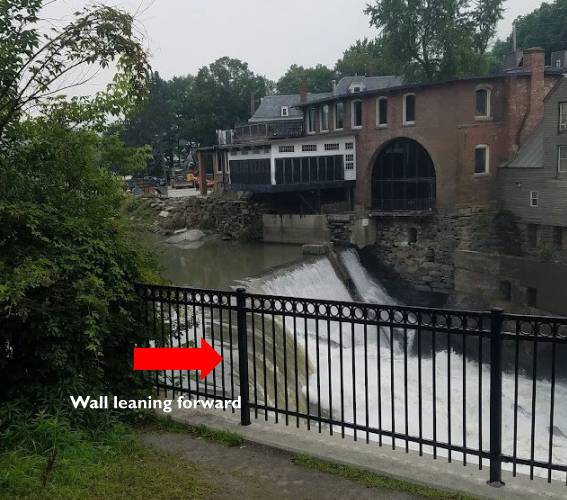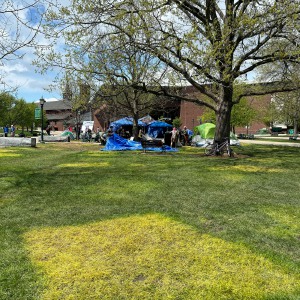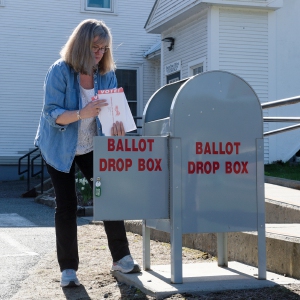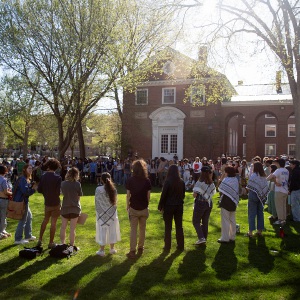Simon Pearce: Quechee dam poses little risk

A photograph taken on Thursday, July 13, 2023, shows a portion of the Ottauquechee River dam next to Simon Pearce in Quechee, Vt., leaning forward. The image was part of the agenda for the Hartford Selectboard's July 18 emergency meeting about the dam and nearby bridge affected by the recent flooding. (Courtesy Town of Hartford) Courtesy town of Hartford
| Published: 07-28-2023 4:41 PM |
QUECHEE — The 200-year-old concrete dam on the Ottauquechee River near the Quechee Covered Bridge poses no imminent threat to public safety, said executives from Simon Pearce — the restaurant and glassblowing company which owns the dam — at a Hartford Selectboard meeting earlier this week.
“I really personally believe that there is no risk of additional concrete breaking off the dam,” said John Lobb, senior vice president of operations at Simon Pearce. “But we need to hope that the water keeps going down so we can get a good look at it and talk to the experts who can help us repair it.”
Earlier this month, Hartford officials warned the public away from the dam after finding “abnormalities” in its structure following flooding and heavy rain two weeks ago. A section on the south side of the dam is shorter than it was before the flooding — potentially due to concrete being ripped off by the swollen Ottauquechee River — according to an inspector from the U.S. Army Corps of Engineers who visited the site.
Tim Schaal, owner of Hartford-based firm Schaal Engineering, said at the meeting that in passing he “put eyes on the dam,” and that he agrees with Lobb’s assessment that there is low risk of further damage.
In Vermont, hydroelectric dams, like the one owned by Simon Pearce, are monitored by the Federal Energy Regulatory Commission, or FERC. Two months before the storm, FERC inspected the dam, which occurs “every two to four years,” Lobb said.
“Every time I’ve met with (FERC), they essentially give the same response: It’s an old dam, very low hazard, concrete’s getting old, continue to monitor it and we’ll see in a couple years,” he said.
Simon Pearce received the commission’s report directing it to continue with business as usual the Monday morning of the flood. “By the end of that day, of course, I was up over my knee in water inside the building,” Lobb said.
FERC has visited the site and is “currently working (with) the owner of the project on a plan and schedule for repairs to the project,” a representative for the commission wrote in an email to the Valley News. The representative did not comment on the risk level posed by the dam in the meantime.
Article continues after...
Yesterday's Most Read Articles
There are more than 360 dams in Vermont, and more than half are classified as high- or significant-hazard, according to the U.S. Army Corps of Engineers’ National Inventory of Dams. The classification means that if those dams fail, they’re likely to cause deaths, property damage or economic loss.
The concrete dam at Simon Pearce, which was constructed in the early 1800s, was originally poured in sections that formed vertical and horizontal seams along the width of its 150-foot face.
“We believe the concrete failed on the south side (of the dam) at one of those seams,” Lobb said. It’s “more than likely” that repairs to the dam will involve plastering every face on the dam with new concrete, he said. Simon Pearce could potentially receive financial support from the federal government, but is otherwise responsible for payment.
Meanwhile, engineers are waiting for water levels to fall enough to open the dam’s spillway, which allows water to flow in a different channel so that officials can assess the face.
Out of concern that the dam would fail, the Vermont Institute for Natural Science, or VINS, closed all of its trails. The nonprofit nature center, located downstream from the dam along the Ottauquechee River, has since opened some on higher ground.
“We made the decision that (trails) upland (of the river) should pose no great risk,” said Chris Collier, VINS’ director for on-site programs, in an interview. Trails closer to the river remained closed.
The Quechee wastewater plant also lies downstream from the dam.
But even if the dam were to fail, Jay Benson, CEO of Simon Pearce, said at Tuesday night’s meeting that there would be no significant threat to areas downstream.
“It’s a dam that was built for hydro(electric) purposes, not flood control purposes,” Benson said, emphasizing that the water behind the dam is shallow.
“That’s all you can empty out. So from my perspective, if the dam failed, it wouldn’t create a flash flood.”
Frances Mize is a Report for America corps member. She can be reached at fmize@vnews.com or 603-727-3242.

 Students take down pro-Palestinian encampment at UVM
Students take down pro-Palestinian encampment at UVM Sharon voters turn back proposal to renovate school
Sharon voters turn back proposal to renovate school Dartmouth administration faces fierce criticism over protest arrests
Dartmouth administration faces fierce criticism over protest arrests
